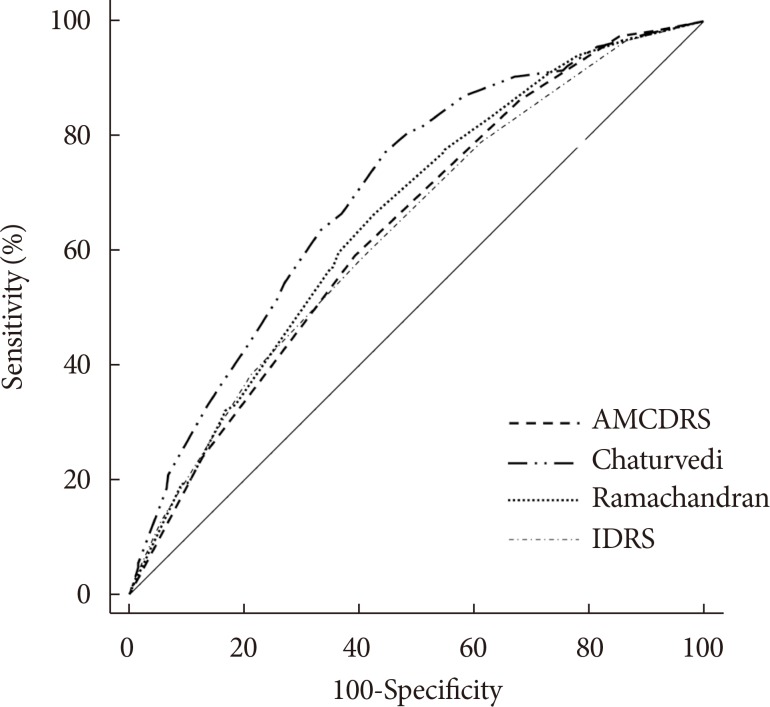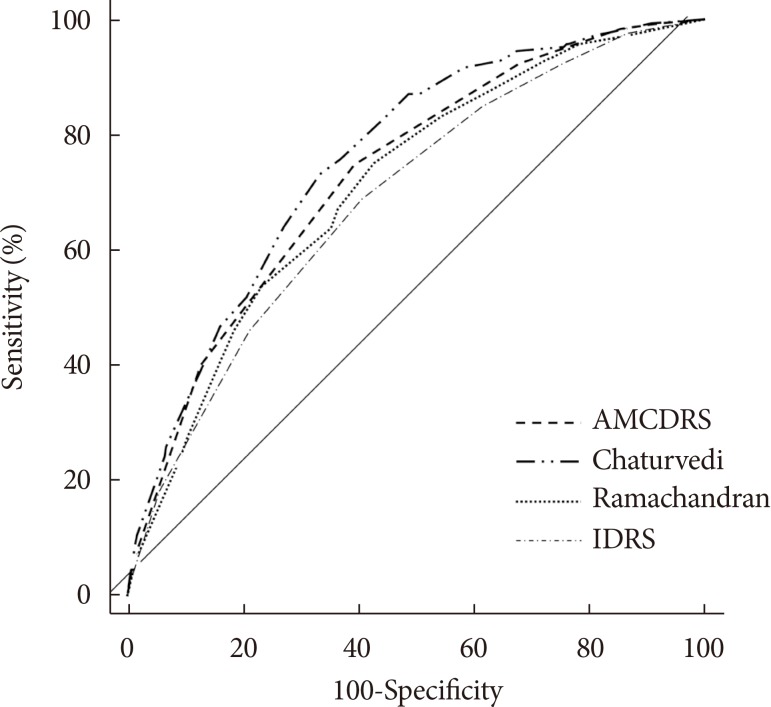Diabetes Metab J.
2017 Oct;41(5):386-392. 10.4093/dmj.2017.41.5.386.
Performance of the Achutha Menon Centre Diabetes Risk Score in Identifying Prevalent Diabetes in Tamil Nadu, India
- Affiliations
-
- 1Department of Community Health, Christian Medical College, Vellore, India. anuoommen@cmcvellore.ac.in
- 2Centre for Population Health Sciences, Nanyang Technological University,Singapore, Singapore.
- 3Department of Cardiology, Christian Medical College, Vellore, India.
- KMID: 2392482
- DOI: http://doi.org/10.4093/dmj.2017.41.5.386
Abstract
- BACKGROUND
The Achutha Menon Centre Diabetes Risk Score (AMCDRS), which was developed in rural Kerala State, South India, had not previously been externally validated. We examined the performance of the AMCDRS in urban and rural areas in the district of Vellore in the South Indian state of Tamil Nadu, and compared it with other diabetes risk scores developed from India.
METHODS
We used the data from 4,896 participants (30 to 64 years) of a cross-sectional study conducted in Vellore (2010 to 2012), to calculate the AMCDRS scores using age, family history, and waist circumference. Sensitivity, specificity, positive predictive value (PPV), and negative predictive values (NPV), and the area under the receiver operating characteristic curve (AROC) were calculated for undiagnosed and total diabetes.
RESULTS
Of the 4,896 individuals surveyed, 274 (5.6%) had undiagnosed diabetes and 759 (15.5%) had total diabetes. The AMCDRS, with an optimum cut-point of ≥4, identified 45.0% for further testing with 59.5% sensitivity, 60.5% specificity, 9.1% PPV, 95.8% NPV, and an AROC of 0.639 (95% confidence interval [CI], 0.608 to 0.670) for undiagnosed diabetes. The corresponding figures for total diabetes were 75.1%, 60.5%, 25.9%, 93.0%, and 0.731 (95% CI, 0.713 to 0.750), respectively. The AROC for the AMCDRS was not significantly different from that of the Indian Diabetes Risk Score, the Ramachandran or the Chaturvedi risk scores for total diabetes, but was significantly lower than the AROC of the Chaturvedi score for undiagnosed diabetes.
CONCLUSION
The AMCDRS is a simple diabetes risk score that can be used to screen for undiagnosed and total diabetes in low-resource primary care settings in India. However, it probably requires recalibration to improve its performance for undiagnosed diabetes.
Keyword
MeSH Terms
Figure
Reference
-
1. International Diabetes Federation. IDF diabetes atlas. 7th ed. Brussels: International Diabetes Federation;2015.2. Knowler WC, Barrett-Connor E, Fowler SE, Hamman RF, Lachin JM, Walker EA, Nathan DM. Diabetes Prevention Program Research Group. Reduction in the incidence of type 2 diabetes with lifestyle intervention or metformin. N Engl J Med. 2002; 346:393–403. PMID: 11832527.
Article3. Ramachandran A, Snehalatha C, Mary S, Mukesh B, Bhaskar AD, Vijay V. Indian Diabetes Prevention Programme (IDPP). The Indian Diabetes Prevention Programme shows that lifestyle modification and metformin prevent type 2 diabetes in Asian Indian subjects with impaired glucose tolerance (IDPP-1). Diabetologia. 2006; 49:289–297. PMID: 16391903.
Article4. Lindstrom J, Louheranta A, Mannelin M, Rastas M, Salminen V, Eriksson J, Uusitupa M, Tuomilehto J. Finnish Diabetes Prevention Study Group. The Finnish Diabetes Prevention Study (DPS): lifestyle intervention and 3-year results on diet and physical activity. Diabetes Care. 2003; 26:3230–3236. PMID: 14633807.5. Herman WH, Smith PJ, Thompson TJ, Engelgau MM, Aubert RE. A new and simple questionnaire to identify people at increased risk for undiagnosed diabetes. Diabetes Care. 1995; 18:382–387. PMID: 7555482.
Article6. Bang H, Edwards AM, Bomback AS, Ballantyne CM, Brillon D, Callahan MA, Teutsch SM, Mushlin AI, Kern LM. Development and validation of a patient self-assessment score for diabetes risk. Ann Intern Med. 2009; 151:775–783. PMID: 19949143.
Article7. Lindstrom J, Tuomilehto J. The diabetes risk score: a practical tool to predict type 2 diabetes risk. Diabetes Care. 2003; 26:725–731. PMID: 12610029.8. Glumer C, Carstensen B, Sandbaek A, Lauritzen T, Jorgensen T, Borch-Johnsen K. Inter99 study. A Danish diabetes risk score for targeted screening: the Inter99 study. Diabetes Care. 2004; 27:727–733. PMID: 14988293.9. Mohan V, Deepa R, Deepa M, Somannavar S, Datta M. A simplified Indian Diabetes Risk Score for screening for undiagnosed diabetic subjects. J Assoc Physicians India. 2005; 53:759–763. PMID: 16334618.10. Ramachandran A, Snehalatha C, Vijay V, Wareham NJ, Colagiuri S. Derivation and validation of diabetes risk score for urban Asian Indians. Diabetes Res Clin Pract. 2005; 70:63–70. PMID: 16126124.
Article11. Chaturvedi V, Reddy KS, Prabhakaran D, Jeemon P, Ramakrishnan L, Shah P, Shah B. Development of a clinical risk score in predicting undiagnosed diabetes in urban Asian Indian adults: a population-based study. CVD Prev Control. 2008; 3:141–151.12. John J, Muliyil J, Balraj V. Screening for hypertension among older adults: a primary care “high risk” approach. Indian J Community Med. 2010; 35:67–69. PMID: 20606923.
Article13. Mathews E, Salvo D, Sarma PS, Thankappan KR, Pratt M. Adapting and validating the Global Physical Activity Questionnaire (GPAQ) for Trivandrum, India, 2013. Prev Chronic Dis. 2016; 13:E53. PMID: 27103263.
Article14. Sathish T, Kannan S, Sarma PS, Thankappan KR. Achutha Menon Centre Diabetes Risk Score: a type 2 diabetes screening tool for primary health care providers in rural India. Asia Pac J Public Health. 2015; 27:147–154. PMID: 22865719.15. Thankappan KR, Shah B, Mathur P, Sarma PS, Srinivas G, Mini GK, Daivadanam M, Soman B, Vasan RS. Risk factor profile for chronic non-communicable diseases: results of a community-based study in Kerala, India. Indian J Med Res. 2010; 131:53–63. PMID: 20167974.16. World Health Organization. STEP wise approach to surveillance. cited 2017 Jun 18. Available from: http://www.who.int/chp/steps/en/.17. Oommen AM, Abraham VJ, George K, Jose VJ. Rising trend of cardiovascular risk factors between 1991-1994 and 2010-2012: a repeat cross sectional survey in urban and rural Vellore. Indian Heart J. 2016; 68:263–269. PMID: 27316476.
Article18. Oommen AM, Abraham VJ, George K, Jose VJ. Prevalence of coronary heart disease in rural and urban Vellore: a repeat cross-sectional survey. Indian Heart J. 2016; 68:473–479. PMID: 27543468.
Article19. Basu S, Millett C, Vijan S, Hayward RA, Kinra S, Ahuja R, Yudkin JS. The health system and population health implications of large-scale diabetes screening in India: a microsimulation model of alternative approaches. PLoS Med. 2015; 12:e1001827. PMID: 25992895.
Article20. World Health Organization. Cost effectiveness and strategic planning (WHO-CHOICE). cited 2017 Jun 18. Available from: http://www.who.int/choice/cost-effectiveness/en/.21. Erasmus RT, Blanco Blanco E, Okesina AB, Mesa Arana J, Gqweta Z, Matsha T. Importance of family history in type 2 black South African diabetic patients. Postgrad Med J. 2001; 77:323–325. PMID: 11320276.
Article22. Turi KN, Buchner DM, Grigsby-Toussaint DS. Predicting risk of type 2 diabetes by using data on easy-to-measure risk factors. Prev Chronic Dis. 2017; 14:E23. PMID: 28278129.
Article23. Sathish T, Kannan S, Sarma SP, Thankappan KR. Screening performance of diabetes risk scores among Asians and Whites in rural Kerala, India. Prev Chronic Dis. 2013; 10:E37. PMID: 23517580.
Article24. Izzo R, de Simone G, Chinali M, Iaccarino G, Trimarco V, Rozza F, Giudice R, Trimarco B, De Luca N. Insufficient control of blood pressure and incident diabetes. Diabetes Care. 2009; 32:845–850. PMID: 19223610.
Article25. World Health Organization. Definition and diagnosis of diabetes mellitus and intermediate hyperglycemia: report of a WHO/IDF consultation. cited 2017 Jun 18. http://www.who.int/diabetes/publications/Definition%20and%20diagnosis%20of%20diabetes_new.pdf.26. Mohan V, Sandeep S, Deepa R, Shah B, Varghese C. Epidemiology of type 2 diabetes: Indian scenario. Indian J Med Res. 2007; 125:217–230. PMID: 17496352.
- Full Text Links
- Actions
-
Cited
- CITED
-
- Close
- Share
- Similar articles
-
- Trends in Performance Using Early Speech Perception Test in Typically Developing Tamil-Speaking Children
- Intraocular Pressure and Its Determinants in Subjects With Type 2 Diabetes Mellitus in India
- Hounsfield units in pseudo subarachnoid hemorrhage: worth looking for
- Limb Salvage Surgery in a Rare Case of Recurrent Parosteal Osteosarcoma with Vascular Graft Thrombosis
- Perception of Tamil Mono-Syllabic and Bi-Syllabic Words in Multi-Talker Speech Babble by Young Adults with Normal Hearing



